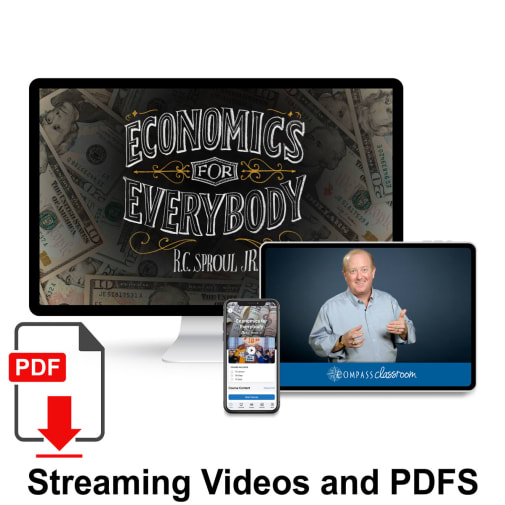Subtitled "Applying Biblical Principles to Work, Wealth and the World", this complete course discusses foundational economic theory from a Biblical perspective. The author, R.C. Sproul, Jr., strongly asserts that economics is not separate from other world systems or separate from the Christian perspective, but they are interwoven and affect each other. Lessons follow a thematic progression: key economic principles introduced (Chapters 1-5); relationship between economics and theology (Chapters 6-7) and finally, real-life application (Chapters 8-12). Individual chapters cover stewardship in God’s image; law, liberty & government; production, property and tools; money, markets and trade; capital, calculation & profit; God and politics; economic philosophies & systems; basic principles & education; inflation & depressions; costs of redistribution; the real effects of sin and kingdom economics. Each of these units includes an approximately 20 min digital lecture with Scriptural support, lecture outlines, short answer and discussion questions, and additional reading suggestions which help students pursue topical interests. This lifetime digital streaming includes a PDF Student Book and all materials needed for a complete introductory (1/2 credit) course. Unfortunately, no answers are provided. The course lectures and reading make up the main course content. After listening to the lectures, students read the student book and process the information via discussion and short answer questions provided via PDF. Note: answers are not included. For a full-year, upper-level course that delves deeper into more traditional economics concepts, add the suggested text, Basic Economics, 4 ed. After purchasing this digital course, you’ll receive an email with a link taking you to compassclassroom.com where you’ll create a new user account (or log into your existing account). The course will be added to your courses dashboard on mycompassclassroom.com. ~ Ruth
Economics for Everybody (Digital) - Streaming Videos and PDFS
Product Overview
- Includes digital study book; printed study book also available
- Highlights the connection between economic and religious freedom
- Half credit course, with potential full credit option
Description
If you’re confused about teaching high school economics for
homeschool, this is the place to begin. RC Sproul, Jr.’s consummate
teaching is illustrated with hundreds of fun and interesting clips from
old movies, cartoons, and instructional videos. The goal of this series
is to make learning economics interesting and enjoyable.
This course covers:
- How economic freedom is directly related to religious freedom;
- The roles of trade, markets, money, and entrepreneurship;
- The differences between socialism, interventionism, and free markets;
- How stewardship is at the heart of a healthy economic system.
Economics for Everybody is designed to be a one-semester economics class for homeschool high school students. The course can be used in two ways:
- Video course with included digital Study Guide. This is a stand-alone study to introduce basic economic concepts and worldview thinking. This is your standard 1/2 high school credit for a semester of economics. Printed copies of the Study Guide are sold separately.
- Video course, included digital Study Guide, and printed Textbook. When our video course is paired with Basic Economics, Fourth Edition, students can go deeper into free market economics, competing economic ideas, and different worldviews. This option would satisfy a full high school credit. You will need to purchase a print copy of the textbook. We do not sell a digital version of the textbook.
Economics for Everybody: Applying Biblical Principles to Work, Wealth, and the World asserts that Christian theology, philosophy, and economics are inescapably interwoven and influence each other. The 12 units, complete with 20 minute digital lectures, succinctly provide reading material, scriptural support, lecture outlines, short answer and discussion questions, and additional reading suggestions, which help students pursue topical interests.
The Study Guide is required, but comes included in the lifetime Digital Streaming for a complete introductory 1/2 credit course. Print versions of the student book are available separately. The course lectures and reading comprise the main course content. After listening to the lectures, students read the student book and process the information via discussion and short answer questions provided via PDF. Answers are not included. For a full-year, upper-level course that delves deeper into more traditional economics concepts, add the suggested Basic Economics, 4th Edition textbook.
| Product Format: | Other |
|---|---|
| Grades: | 7-AD |
| Brand: | Compass Classroom |
| EAN/UPC: | ECONDIG |

